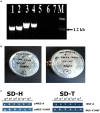Tyrosine Phosphorylation Based Homo-dimerization of Arabidopsis RACK1A Proteins Regulates Oxidative Stress Signaling Pathways in Yeast
- PMID: 26941753
- PMCID: PMC4764707
- DOI: 10.3389/fpls.2016.00176
Tyrosine Phosphorylation Based Homo-dimerization of Arabidopsis RACK1A Proteins Regulates Oxidative Stress Signaling Pathways in Yeast
Abstract
Scaffold proteins are known as important cellular regulators that can interact with multiple proteins to modulate diverse signal transduction pathways. RACK1 (Receptor for Activated C Kinase 1) is a WD-40 type scaffold protein, conserved in eukaryotes, from Chlamydymonas to plants and humans, plays regulatory roles in diverse signal transduction and stress response pathways. RACK1 in humans has been implicated in myriads of neuropathological diseases including Alzheimer and alcohol addictions. Model plant Arabidopsis thaliana genome maintains three different RACK1 genes termed RACK1A, RACK1B, and RACK1C with a very high (85-93%) sequence identity among them. Loss of function mutation in Arabidopsis indicates that RACK1 proteins regulate diverse environmental stress signaling pathways including drought and salt stress resistance pathway. Recently deduced crystal structure of Arabidopsis RACK1A- very first among all of the RACK1 proteins, indicates that it can potentially be regulated by post-translational modifications, like tyrosine phosphorylations and sumoylation at key residues. Here we show evidence that RACK1A proteins, depending on diverse environmental stresses, are tyrosine phosphorylated. Utilizing site-directed mutagenesis of key tyrosine residues, it is found that tyrosine phosphorylation can potentially dictate the homo-dimerization of RACK1A proteins. The homo-dimerized RACK1A proteins play a role in providing UV-B induced oxidative stress resistance. It is proposed that RACK1A proteins ability to function as scaffold protein may potentially be regulated by the homo-dimerized RACK1A proteins to mediate diverse stress signaling pathways.
Keywords: Arabidopsis; RACK1A; UV-B; homo-dimerization; oxidative stress; split-ubiquitin; yeast.
Figures




Similar articles
-
RACK1 genes regulate plant development with unequal genetic redundancy in Arabidopsis.BMC Plant Biol. 2008 Oct 23;8:108. doi: 10.1186/1471-2229-8-108. BMC Plant Biol. 2008. PMID: 18947417 Free PMC article.
-
Arabidopsis scaffold protein RACK1A interacts with diverse environmental stress and photosynthesis related proteins.Plant Signal Behav. 2013 May;8(5):e24012. doi: 10.4161/psb.24012. Epub 2013 Feb 22. Plant Signal Behav. 2013. PMID: 23435172 Free PMC article.
-
Arabidopsis receptor of activated C kinase1 phosphorylation by WITH NO LYSINE8 KINASE.Plant Physiol. 2015 Feb;167(2):507-16. doi: 10.1104/pp.114.247460. Epub 2014 Dec 8. Plant Physiol. 2015. PMID: 25489024 Free PMC article.
-
The Receptor for Activated C Kinase in Plant Signaling: Tale of a Promiscuous Little Molecule.Front Plant Sci. 2015 Dec 8;6:1090. doi: 10.3389/fpls.2015.01090. eCollection 2015. Front Plant Sci. 2015. PMID: 26697044 Free PMC article. Review.
-
Phosphorylation of RACK1 in plants.Plant Signal Behav. 2015;10(8):e1022013. doi: 10.1080/15592324.2015.1022013. Plant Signal Behav. 2015. PMID: 26322575 Free PMC article. Review.
Cited by
-
Asc1p/RACK1 Connects Ribosomes to Eukaryotic Phosphosignaling.Mol Cell Biol. 2017 Jan 19;37(3):e00279-16. doi: 10.1128/MCB.00279-16. Print 2017 Feb 1. Mol Cell Biol. 2017. PMID: 27821475 Free PMC article.
-
miR393s regulate salt stress response pathway in Arabidopsis thaliana through scaffold protein RACK1A mediated ABA signaling pathways.Plant Signal Behav. 2019;14(6):1600394. doi: 10.1080/15592324.2019.1600394. Epub 2019 Apr 25. Plant Signal Behav. 2019. PMID: 31021701 Free PMC article.
-
Ribosomal protein RACK1 enhances translation of poliovirus and other viral IRESs.Virology. 2020 Jun;545:53-62. doi: 10.1016/j.virol.2020.03.004. Epub 2020 Mar 25. Virology. 2020. PMID: 32308198 Free PMC article.
-
Integrative Proteomic and Phosphoproteomic Analyses Revealed the Regulatory Mechanism of the Response to Ultraviolet B Stress in Clematis terniflora DC.ACS Omega. 2022 Dec 29;8(1):1652-1662. doi: 10.1021/acsomega.2c07258. eCollection 2023 Jan 10. ACS Omega. 2022. PMID: 36643485 Free PMC article.
-
Proteomic Analysis of Proteins Related to Defense Responses in Arabidopsis Plants Transformed with the rolB Oncogene.Int J Mol Sci. 2023 Jan 18;24(3):1880. doi: 10.3390/ijms24031880. Int J Mol Sci. 2023. PMID: 36768198 Free PMC article.
References
-
- Chen K., Liang N., Yang J., Zhao H. (2012). “UV-B irradiation regulates apoptosis in yeast,” in Proceedings of the 2012 International Conference on Applied Biotechnology Vol. 251 eds Zhang T.-C., Ouyang P., Kaplan S., Skarnes B. (New York, NY: Springer Science & Business Media; ), 1869–1879. 10.1007/978-3-642-37925-3_201 - DOI
LinkOut - more resources
Full Text Sources
Other Literature Sources
Molecular Biology Databases

